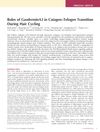TLDR Removing Gsdma1/2/3 genes reduces skin cell overgrowth by blocking a specific cell pathway.
The study explores the role of Gsdma1/2/3 genes in PMA-induced epidermal hyperplasia and inflammation, finding that their depletion in knockout mice alleviates these conditions by inhibiting the EGFR–Stat3/Akt pathway. This suggests that Gsdma1/2/3 genes are crucial for keratinocyte proliferation and that targeting these genes could be a potential therapeutic strategy for skin disorders characterized by epidermal hyperplasia. The research highlights the importance of the EGFR–Stat3/Akt pathway in regulating epidermal cell proliferation and suggests that Gsdma1/2/3 may act as stress-associated activators in response to external stimuli or internal disease changes.
37 citations
,
November 2019 in “Journal of Microbiology and Biotechnology” Loliolide can boost hair growth by activating specific cell pathways.
54 citations
,
December 2011 in “American Journal Of Pathology” A Gsdma3 mutation causes hair loss due to stem cell damage from skin inflammation.
30 citations
,
October 2010 in “Biochemical and biophysical research communications” The Gsdma3 gene is essential for normal hair development in mice.
 1039 citations
,
February 2009 in “Nature Reviews Molecular Cell Biology”
1039 citations
,
February 2009 in “Nature Reviews Molecular Cell Biology” Skin stem cells are crucial for maintaining and repairing the skin and hair, using a complex mix of signals to do so.
427 citations
,
April 2008 in “Nature Protocols”
 76 citations
,
June 2015 in “Journal of biomedical science”
76 citations
,
June 2015 in “Journal of biomedical science” Mutations in Gasdermin A3 cause skin inflammation and hair loss by disrupting mitochondria.
12 citations
,
July 2015 in “Experimental Dermatology” Gasdermin A3 overexpression in skin causes inflammation and hair loss.
9 citations
,
August 2021 in “International journal of molecular sciences” PPARγ is essential for maintaining healthy skin, controlling inflammation, and ensuring proper skin barrier function.
 25 citations
,
April 2015 in “Journal of Investigative Dermatology”
25 citations
,
April 2015 in “Journal of Investigative Dermatology” GasderminA3 is important for normal hair cycle transitions by controlling Wnt signaling.
30 citations
,
October 2010 in “Biochemical and biophysical research communications” The Gsdma3 gene is essential for normal hair development in mice.


